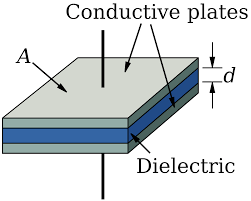The Capacitance Calculator calculates the Capacitance of a Parallel Plate Capacitor.
Capacitance Calculator
The capacitance of a parallel plate capacitor is given by the formula:
C = ε * A / d
Where:
- C is the capacitance of the capacitor (measured in Farads, F)
- ε is the permittivity of the dielectric material between the plates (measured in Farads per meter, F/m)
- A is the area of the plates that are facing each other (measured in square meters, m²)
- d is the distance between the plates (measured in meters, m)
This formula applies to an ideal parallel plate capacitor where the electric field between the plates is uniform, and the dielectric material is considered homogeneous.

The capacitance of a parallel plate capacitor directly depends on the area of the plates and the permittivity of the material between them. It is inversely proportional to the distance between the plates. A larger area, higher permittivity, and a smaller distance all contribute to a higher capacitance value.
It’s important to note that the actual capacitance of a real-world capacitor might also be influenced by factors like the specific design of the capacitor and the quality of the dielectric material used.
Capacitance is a fundamental concept in the field of electrical engineering and physics. It refers to the ability of a component, known as a capacitor, to store an electric charge when a voltage difference (potential difference) exists between its two plates or conductive surfaces. In other words, capacitance quantifies how much charge can be stored in a capacitor for a given voltage.
A capacitor consists of two conductive plates separated by a dielectric material. When a voltage is applied across the plates, electrons accumulate on one plate, creating a surplus of negative charge, while the other plate experiences a deficit of electrons, resulting in a positive charge. This separation of charges creates an electric field between the plates.
The capacitance of a capacitor is measured in Farads (symbol: F). One Farad is defined as the capacitance that stores one Coulomb of charge when a voltage of one Volt is applied across the plates. However, capacitors used in most practical applications are often measured in microfarads (µF), nano-farads (nF), or pico-farads (pF), which are smaller units of capacitance.
The formula for calculating the capacitance of a capacitor is:
C = Q / V
Where:
- C is the capacitance (measured in Farads)
- Q is the charge stored on the capacitor (measured in Coulombs)
- V is the voltage across the capacitor (measured in Volts)
Capacitors are essential components in electronic circuits and systems, used for tasks such as energy storage, filtering, timing, and coupling. They play a crucial role in various devices, including power supplies, radios, televisions, computers, and many other electronic gadgets.